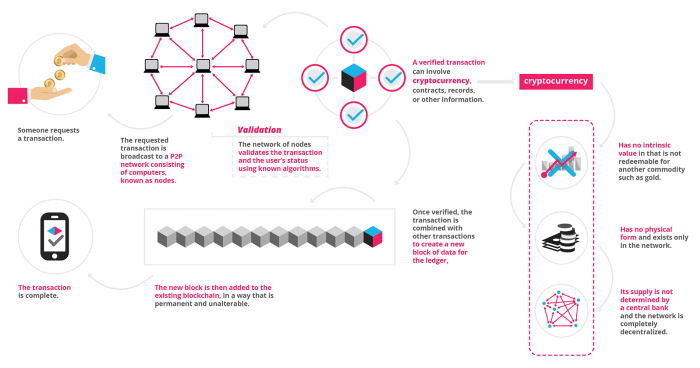Is the ‘blockchain revolution’ coming for science?
Blockchain, blockchain, blockchain. You can’t go anywhere these days without hearing this buzzword. Now it seems that it is coming for science, and that’s kinda exciting.
What is the blockchain?
To keep things simple: A blockchain is a continuously growing and immutable list of records (blocks), which are linked (chain) and secured using cryptography. Each block typically contains a cryptographic hash of the previous block, a timestamp and transaction information. Together, these blocks form an openly distributed, peer-to-peer (decentralised) ‘ledger’ of records between different parties.

At the APE meeting in Berlin in January 2018, the audience were asked when do they think the first blockchain-based services would be available for scientific research and communication. Most thought 2-5 years, based on the small proportion who genuinely understood what the potential disruptive power of decentralised technologies were. Turns out we were all wrong anyway, as these things are being built and exist right now!
In the last 2 days, FOUR new science-oriented services independently came to my attention. So it seems like momentum is certainly gathering:
- Scienceroot: The first blockchain-based scientific ecosystem. Hosting a collaboration platform, funding platform and journal (Twitter).
- Open Science Network: A shared open protocol on the blockchain where researchers, universities, companies with R&D budgets and government institutions can interact effectively with lower barriers to entry and reduced friction in each step of the process (Twitter).
- Ivory Publishing: Open-access scientific publishing platform built on blockchain technology (they don’t seem to have a website yet, but it does have an elephant for a logo).
- DEIP: A decentralised research platform (Twitter).
These new services join a bunch of existing ones such as the PLUTO Network and Aletheia, all designed around disrupting the way we perform and communicate research.
Why is this important?
Blockchain-based services, and those based on similar technology, are what we call ‘decentralised’. This means that services and power/control are taken from a single point and distributed across numerous local points instead. This means that there is no single point of failure, and that services/control become owned by community-based structures instead.
Can you imagine legacy publishers like Wiley, Elsevier, and SpringerNature being too happy with that? I can’t. Elsevier, and others like Digital Science, are trying to pull researchers into a system where they control the entire research workflow, from data collection all the way through to evaluation (more on this here). Great for business, bad for science, and especially scientific freedom – a basic co-opting of ‘open science’. Decentralised services, therefore, provide an alternative to this, and a highly disruptive potential.
So, well worth watching future developments in this field. If you want to learn more, check out the ‘Blockchain for Science‘ initiative, spear-headed by Sönke Bartling.
Thanks for this. For other examples and discussions, see the items tagged with “oa.blockchain” by the Open Access Tracking Project.
http://tagteam.harvard.edu/hubs/oatp/tag/oa.blockchain
protohedgehog, thanks! And thanks for sharing your great posts every week!
I like the concept of mining coins through a browser..like Operabut i like POS coins in general..because in the decentralised world that blockchain wants to build resources must be well and better distributed.. you covered Pivx and Zcoin recently..i like privacy coins as well..there are other interesting coins that are growing fast like DeepOnion, Verge and Hush..I have personally invested some money in DeepOnion and have already made some nice profits..
Digital Science are getting involved too:
https://www.digital-science.com/blog/news/blockchain-technologies-for-peer-review/